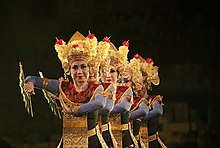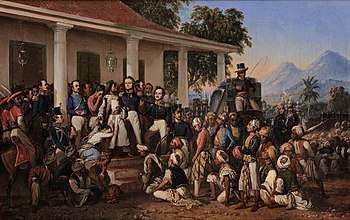Culture of Indonesia
The culture of Indonesia has been shaped by long interaction between original indigenous customs and multiple foreign influences. Indonesia is centrally-located along ancient trading routes between the Far East, South Asia and the Middle East, resulting in many cultural practices being strongly influenced by a multitude of religions, including Buddhism, Christianity, Confucianism, Hinduism and Islam, all strong in the major trading cities. The result is a complex cultural mixture very different from the original indigenous cultures.

| Part of a series on the |
| Culture of Indonesia |
|---|
 |
| History |
| People |
| Languages |
| Cuisine |
| Literature |
|
Music and performing arts |
|
Media
|
| Sport |
|
Monuments |
|
Examples of the fusion of Islam with Hinduism include Javanese Abangan belief, the fusion of Hinduism, Buddhism and animism in Bodha, and the fusion of Hinduism and animism in Kaharingan; others could be cited. Balinese dances have stories about ancient Buddhist and Hindu kingdoms, while Islamic art forms and architecture are present in Sumatra, especially in the Minangkabau and Aceh regions. Traditional art, music and sport are combined in a martial art form called Pencak Silat.
The Western world has influenced Indonesia in science, technology and modern entertainment such as television shows, film and music, as well as political system and issues. India has notably influenced Indonesian songs and movies. A popular type of song is the Indian-rhythmical dangdut, which is often mixed with Arab and Malay folk music.
Despite the influences of foreign culture, some remote Indonesian regions still preserve uniquely indigenous culture. Indigenous ethnic groups Mentawai, Asmat, Dani, Dayak, Toraja and many others are still practising their ethnic rituals, customs and wearing traditional clothes.
Traditional performing arts
Music
Indonesia is home to with those from the islands of Java, Sumatra and Bali being frequently recorded. The traditional music of central and East Java and Bali is the gamelan (traditional instruments include : gambang, bonang, saron, petik, gong, dengung, and many more).
On 29 June 1965, Koes Plus, a leading Indonesian pop group in the 1960s, 1970s and 1980s, was imprisoned in Glodok, West Jakarta, for playing Western-style music. After the resignation of President Sukarno, the law was rescinded, and in the 1970s the Glodok prison was dismantled and replaced with a large shopping mall.
Kroncong is a musical genre that uses guitars and ukulele as the main musical instruments. This genre had its roots in Portugal and was introduced by Portuguese traders in the 15th century. There is a traditional Keroncong Tugu music group in North Jakarta and other traditional Keroncong music groups in Maluku, with strong Portuguese influences. This music genre was popular in the first half of the 20th century; a contemporary form of Kroncong is called Pop Kroncong.
Angklung musical orchestra, native of West Java, received international recognition as UNESCO has listed the traditional West Java musical instrument made from bamboo in the list of intangible cultural heritage.[1][2]
The soft Sasando music from the province of East Nusa Tenggara in West Timor is completely different. Sasando uses an instrument made from a split leaf of the Lontar palm (Borassus flabellifer), which bears some resemblance to a harp. And Indonesia only have a total of 2 islands
Dance
Indonesian dance reflects the diversity of culture from ethnic groups that composed the nation of Indonesia. Austronesian roots and Melanesian tribal dance forms are visible, and influences ranging from neighbouring Asian countries; such as India, China, and Middle East to European western styles through colonisation. Each ethnic group has their own distinct dances; makes total dances in Indonesia are more than 3000 Indonesian original dances. However, the dances of Indonesia can be divided into three eras; the Prehistoric Era, the Hindu/Buddhist Era and the Era of Islam, and into two genres; court dance and folk dance.
There is a continuum in the traditional dances depicting episodes from the Ramayana and Mahabharata from India, ranging through Thailand, all the way to Bali. There is a marked difference, though, between the highly stylised dances of the courts of Yogyakarta and Surakarta and their popular variations. While the court dances are promoted and even performed internationally, the popular forms of dance art and drama must largely be discovered locally.
During the last few years, Saman from Nanggroe Aceh Darussalam has become rather popular and is often portrayed on TV. Reog Ponorogo is also a dance that originated from the district Ponorogo, East Java, which is a visualisation of the legendary story Wengker kingdom and the kingdom of Kediri.
A popular line dance called Poco-poco was originated in Indonesia and also popular in Malaysia, but at early April 2011 Malaysian Islamic clerics banned the poco-poco dance for Muslims due to them believing it is traditionally a Christian dance and that its steps make the sign of the cross.[3]
Drama and theatre
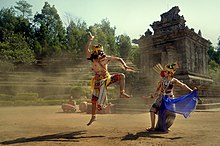
The Wayang show, the Javanese, Sundanese, and Balinese shadow puppet theatre shows display several mythological legends such as Ramayana, Mahabharata, and many more. Wayang Orang is Javanese traditional dance drama based on wayang stories. Various Balinese dance drama also can be included within traditional form of Indonesian drama. Another form of local drama is Javanese Ludruk and Ketoprak, Sundanese Sandiwara, and Betawi Lenong. All of these drama incorporated humor and jest, often involving audiences in their performance.

The shadow puppets are mostly made of sheets of certain items. You can make yours using wax paper and a sheet of translucent plastic, and download templates but those people really do have talent to craft their own and one-of a kind shadow puppets, which are carved one by one segment out of metal or other special materials.
Randai is a folk theatre tradition of the Minangkabau people of West Sumatra, usually performed for traditional ceremonies and festivals. It incorporates music, singing, dance, drama and the silat martial art, with performances often based on semi-historical Minangkabau legends and love story.
Bangsawan is a Malay folk theatre found in the province of Riau.
Modern performing art also developed in Indonesia with their distinct style of drama. Notable theatre, dance, and drama troupe such as Teater Koma are gaining popularity in Indonesia as their drama often portray social and political satires of Indonesian society.
Martial arts
.jpg)
The art of Pencak Silat was created and firstly developed in the islands of Java and Sumatra. It is an art for survival and practised throughout the Indonesian archipelago. Centuries of tribal wars in Indonesian history had shaped silat as it was used by the ancient warriors of Indonesia. Silat was used to determine the rank and position of warriors in old Indonesian kingdoms.
Contacts with Indians and Chinese has further enriched silat. Silat reached areas beyond Indonesia mainly through diaspora of Indonesian people. People from various regions like Aceh, Minangkabau, Riau, Bugis, Makassar, Java, Banjar, etc. moved into and settled in Malay Peninsula and other islands. They brought silat and passed it down to their descendants. The Indonesian of half-Dutch descent are also credited as the first to have brought the art into Europe.
Silat was used by Indonesian independence fighters during their struggle against the Dutch colonial rule. Unfortunately after Indonesia achieving their independence, silat became less popular among Indonesian youth compare to foreign martial arts like Karate and Taekwondo. This probably because silat was not taught openly and only passed down among blood relatives, the other reason is the lack of media portrayal of the art.
Efforts have been made to introduce and reintroduce the beauty of silat to Indonesian youth and the world. Exhibitions and promotions by individuals as well as state-sponsored groups helped the growing of silat's popularity, particularly in Europe and United States. Indonesian 2009 Silat movie Merantau is one of Indonesian efforts to introduce silat to international scene.
Another martial art from Indonesia is Tarung Derajat. It is a modern combat system created by Haji Ahmad Drajat based on his experience as a street fighter. Tarung Drajat has been acknowledge as a national sport by KONI in 1998 and is now used by Indonesian Army as part of their basic training.
Traditional visual arts
Painting
.jpg)

What Indonesian painting before the 19th century are mostly restricted to the decorative arts, considered to be a religious and spiritual activity, comparable to the pre-1400 European art. Artists' names are anonymous, since the individual human creator was seen as far less important than their creation to honour the deities or spirits. Some examples are the Kenyah decorative art, based on endemic natural motifs such as ferns and hornbills, found decorating the walls of Kenyah long houses. Other notable traditional art is the geometric Toraja wood carvings. Balinese painting are initially the narrative images to depict scenes of Balinese legends and religious scripts. The classical Balinese paintings are often decorating the lontar manuscripts and also the ceilings of temples pavilion.
Under the influence of the Dutch colonial power, a trend toward Western-style painting emerged in the 19th century. In the Netherlands, the term "Indonesian Painting" is applied to the paintings produced by Dutch or other foreign artists who lived and worked in the former Netherlands-Indies. The most famous indigenous 19th century Indonesian painter is Raden Saleh (1807–1877), the first indigenous artist to study in Europe. His art is heavily influenced by Romanticism.[4] In the 1920s Walter Spies settled in Bali, he is often credited with attracting the attention of Western cultural figures to Balinese culture and art. His works has somehow influenced Balinese artists and painters. Today Bali has one of the most vivid and richest painting traditions in Indonesia.
The 1920s to 1940s were a time of growing nationalism in Indonesia. The previous period of romanticism movement was not seen as a purely Indonesian movement and did not develop. Painters began to see the natural world for inspiration. Some examples of Indonesian painter during this period are the Balinese Ida Bagus Made and the realist Basuki Abdullah. The Indonesian Painters Association (Persatuan Ahli-Ahli Gambar Indonesia or PERSAGI, 1938–1942) was formed during this period. PERSAGI established a contemporary art philosophy that saw art works as reflections of the artist's individual or personal view as well as an expression of national cultural thoughts.
From the 1940s on, artists started to mix Western techniques with Southeast Asian imagery and content. Painters that rooted in the revolutionary movement of the World War and the post-World War period started to appear during this period, such as Sudjojono, Affandi, and Hendra.[5]
During the 1960s, new elements were added when abstract expressionism and Islamic art began to be absorbed by the art community. Also during this period, group of painters that are more concerned about the reality of Indonesian society began to appear, taking inspiration from the social problem such as division between the rich and the poor, pollution, and deforestation. The national identity of Indonesia was stressed by these painters through the use of a realistic, documentary style. During the Sukarno period this socially-engaged art was officially promoted, but after 1965 it lost popularity due to its presumed communist tendencies.[6]
Three art academies offer extensive formal training in visual art: Bandung Institute of Technology founded in 1947; the Akademi Seni Rupa Indonesia (Indonesian Fine Arts Academy) or ASRI, now known as ISI, in Yogyakarta was inaugurated in 1950; and the Institut Kesenian Jakarta (Jakarta Arts Institute) or IKJ, was opened in 1970.
Sculpture
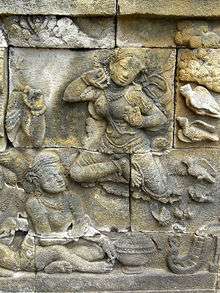
Indonesia has a long history of stone, bronze and Iron Ages arts. The megalithic sculptures can be found in numerous archaeological sites in Sumatra, Java to Sulawesi. The native Indonesians tribes have their own distinct tribal sculpture styles, usually created to depict ancestors, deities and animals. The pre-Hindu-Buddhist and pre-Islamic sculptures can be traced in the artworks of indigenous Indonesian tribes. The most notable sculptures are those of Asmat wooden sculpture of Papua, the Dayak wooden mask and sculpture, the ancestral wooden statue of Toraja, also the totem-like sculpture of Batak and Nias tribe.
The stone sculpture artform particularly flourished in 8th-to-10th-century Java and Bali, which demonstrate the influences of Hindu-Buddhist culture, both as stand-alone works of art and also incorporated into temples. Most notable sculpture of classical Hindu-Buddhist era of Indonesia are the hundreds of meters of relief and hundreds of stone buddhas at the temple of Borobudur in central Java. Approximately two miles of exquisite relief sculpture tell the story of the life of Buddha and illustrate his teachings. The temple was originally home to 504 statues of the seated Buddha. This site, as with others in central Java, show a clear Indian influence.
%2C_xiii_secolo.jpg)
The examples of notable Indonesian Hindu-Buddhist sculptures are; the statues of Hindu deities; Shiva, Vishnu, Brahma, Durga, Ganesha and Agastya enthroned in rooms of Prambanan temples, the Vishnu mounting Garuda statue of king Airlangga, the exquisite statue of Eastern Javanese Prajnaparamita and 3.7 meters tall Dvarapala dated from Singhasari period, and also the grand statue of Bhairava Adityawarman discovered in Sumatra. Today, the Hindu-Buddhist style stone sculptures are reproduced in villages in Muntilan near Borobudur also in Trowulan the former capital site of Majapahit in East Java, and Bali, and sold as garden or pool ornament statues for homes, offices and hotels.
Today in Indonesia, the richest, most elaborate and vivid wooden sculpture and wood carving traditions can be found in Bali and Jepara, Central Java. Balinese handicrafts such as sculptures, masks, and other carving artworks are popular souvenir for tourist that have visited Indonesia. On the other hand, the Jepara wood carving are famous for its elaborately carved wooden furnitures, folding screens also pelaminan gebyok (wedding throne with carved background).
Architecture
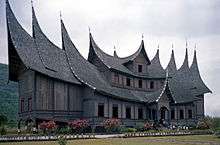
For centuries, the Indonesian vernacular architecture has shaped settlements in Indonesia which commonly took form of timber structures built on stilts dominated by large roof. The most dominant foreign influences on Indonesian architecture were Indian, although European influences have been particularly strong since the 19th century and modern architecture in Indonesia is international in scope.
As in much of South East Asia, traditional vernacular architecture in Indonesia are built on stilts, with the significant exceptions of Java and Bali. Notable stilt houses are those of the Dayak people in Borneo, the Rumah Gadang of the Minangkabau people in western Sumatra, the Rumah Bolon of the Batak people in northern Sumatra, and the Tongkonan of the Toraja people in Sulawesi. Oversized saddle roofs with large eaves, such as the homes of the Batak and the tongkonan of Toraja, are often bigger than the house they shelter. The fronts of Torajan houses are frequently decorated with buffalo horns, stacked one above another, as an indication of status. The outside walls also frequently feature decorative reliefs.
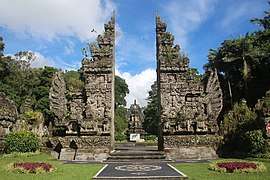

The 8th-century Borobudur temple near Yogyakarta is the largest Buddhist temple in the world, and is notable for incorporating about 2,672 relief panels and 504 Buddha statues into its structure, telling the story of the life of the Buddha. As the visitor ascends through the eight levels of the temple, the story unfolds, the final three levels simply containing stupas and statues of the Buddha. The building is said to incorporate a map of the Buddhist cosmos and is a masterful fusion of the didactic narrative relief, spiritual symbolism, monumental design and the serene meditative environs. The whole monument itself resembles a giant stupa, but seen from above it forms a mandala.[7]
The nearby 9th-century temple complex at Prambanan contains some of the best preserved examples of Hindu temple architecture in Java. The temple complex comprises eight main shrines, surrounded by 224 smaller shrines. The Indian influence on the site is clear, not only in the style of the monument, but also in the reliefs featuring scenes from the Ramayana which adorn the outer walls of the main temples, and in the votive statuary found within.
Crafts
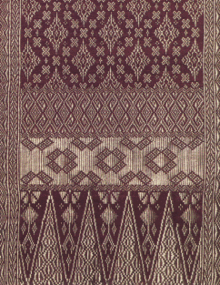
Indonesia is considered as home of world handicraft.[8] Every ethnic group has its own uniqueness, style, and philosophy of crafting.[8] Most of them are made from wooden, bone, fabric, stone, and paper. These natural materials were crafted using hands into profitable and aesthetic items.[8] Handicraft manufacturing serves not only as an important economic sector, but also a tradition and has a social function as well.[9] The handicraft industry employs thousands of people in towns and villages across the country. About half a billion dollar worth of handicraft is exported every year, and many more is consumed domestically.[8][9]

There are many varieties of handicraft from other regions.[8] West Sumatra and South Sumatra are particularly noted for their songket cloths.[10] Villages in the Lesser Sunda Islands produce ikat while provinces in Kalimantan are long known for their basketry and weaving using rattan and other natural fabrics.[11] Wood art produced by the Asmat people of Papua is highly valued.[12] Cities along Java's northern coast, Cirebon, Pekalongan, and Rembang are known as centres of batik.[13] Cirebon and Jepara are important cities in furniture, producing rattan and carved wood respectively,[14] while Tasikmalaya is known for embroidery.[15] Pasuruan also produces furniture and other products and support stores and galleries in Bali.[8] Bandung and Surabaya, both modern, cosmopolitan, and industrialised cities—much like Jakarta but on a lesser scale—are creative cities with a variety of innovative startups.[8]
Several Indonesian islands are famous for their batik, ikat and songket cloth. Once on the brink of disappearing, batik and later ikat, found a new lease on life when former President Suharto promoted wearing batik shirts on official occasions. In addition to the traditional patterns with their special meanings, used for particular occasions, batik designs have become creative and diverse over the last few years.
Other noted Indonesian crafts are Jepara wood carving[16] and Kris. In 2005, UNESCO recognised Kris as one of Masterpiece of the Oral and Intangible Heritage of Humanity from Indonesia.[17]
Clothing
Indonesia's best-known national costumes is Batik and kebaya, although initially these costumes originated mainly from Javanese and Balinese culture, which are most prominent in Javanese, Sundanese and Balinese cultures. Because Java has become the political center and population of Indonesia, the island's folk costume has been raised to national status. As a plural country, Indonesia has 34 provinces, each of which has representatives of traditional clothing from each province with unique and different designs. National costumes are worn at official occasions and traditional ceremonies. each province in Indonesia - more complete each group in Indonesia, has its own traditional costumes. The costumes of this area are in Indonesian called Pakaian tradisional or Pakaian adat, and are taken from traditional Indonesian textile traditions and crafts.
Literature
Pramoedya Ananta Toer was Indonesia's most internationally celebrated author, having won the Magsaysay Award as well as being considered for the Nobel Prize in Literature. Other important figures include the late Chairil Anwar, a poet and member of the "Generation 45" group of authors who were active in the Indonesian independence movement. Tight information controls during Suharto's presidency suppressed new writing, especially because of its ability to agitate for social reform.
In the book Max Havelaar, Dutch author Multatuli criticised the Dutch treatment of the Indonesians, which gained him international attention.
Modern Indonesian authors include Seno Gumira Adjidarma, Andrea Hirata, Habiburrahman El Shirazy, Ayu Utami, Gus tf Sakai, Eka Kurniawan, Ratih Kumala, Dee, Oka Rusmini. Some of their works have translated to other languages.
Poetry
There is a long tradition in Indonesia, particularly among ethnically Malay populations, of extemporary, interactive, oral composition of poetry. These poems are referred to as pantun. Contemporary Indonesian poets include among others, Sutardji Calzoum Bachri, Rendra, Taufiq Ismail, Afrizal Malna,[18] Binhad Nurrohmat, Joko Pinurbo, Sapardi Djoko Damono.
Foods

The cuisine of indonesia has been influenced by Chinese culture and Indian culture, as well as by Western culture. However, in return, Indonesian cuisine has also contributed to the cuisines of neighbouring countries, notably Malaysia and Singapore, where Padang or Minangkabau cuisine from West Sumatra is very popular. Also Satay (Sate in Indonesian), which originated from Java, Madura, and Sumatra, has gained popularity as a street vendor food from Singapore to Thailand. In the 15th century, both the Portuguese and Arab traders arrived in Indonesia with the intention of trading for pepper and other spices. During the colonial era, immigrants from many countries arrived in Indonesia and brought different cultures as well as cuisines.


Most native Indonesians eat rice as the main dish, with a wide range of vegetables and meat as side dishes. However, in some parts of the country, such as Irian Jaya and Ambon, the majority of the people eat sago (a type of tapioca) and sweet potato.
In some places people eat Pempek, a type of indonesian traditional dish (refer to pempek;website), and also Rendang (refer to picture on top-left of this topic {FOODS}.
The most important aspect of modern Indonesian cuisine is that food must be halal, conforming to Islamic food laws. Haraam, the opposite of halal, includes pork and alcohol. However, in some regions where there is a significant non-Muslim population, non-halal foods are also commonly served.
Indonesian dishes are usually spicy, using a wide range of chili peppers and spices. The most popular dishes include nasi goreng (fried rice), Satay, Nasi Padang (a dish of Minangkabau) and soy-based dishes, such as tofu and tempe. A unique characteristic of some Indonesian food is the application of spicy peanut sauce in their dishes, as a dressing for Gado-gado or Karedok (Indonesian style salad), or for seasoning grilled chicken satay. Another unique aspect of Indonesian cuisine is using terasi or belacan, a pungent shrimp paste in dishes of sambal oelek (hot pungent chili sauce). The sprinkling of fried shallots also gives a unique crisp texture to some Indonesian dishes.
Chinese and Indian cultures have influenced the serving of food and the types of spices used. It is very common to find Chinese food in Indonesia such as Dim Sum and noodles, and Indian cuisine such as Tandoori chicken. In addition, Western culture has significantly contributed to the extensive range of dishes. However, the dishes have been transformed to suit Indonesian tastes. For example, steaks are usually served with rice. Popular fast foods such as Kentucky Fried Chicken are served with rice instead of bread and sambal (spicy sauce) instead of ketchup. Some Indonesian foods have been adopted by the Dutch, like Indonesian rice table or 'rijsttafel'.
Recreation and sports
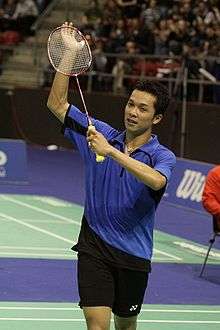
Many traditional games are still preserved and popular in Indonesia, although western culture has influenced some parts of them. Among three hundred officially recognised Indonesian cultures, there are many kinds of traditional games: cockfighting in Bali, annual bull races in Madura, and stone jumping in Nias. Stone jumping involves leaping over a stone wall about up to 1.5 m high and was originally used to train warriors. Pencak Silat is another popular form of sport, which was influenced by Asian culture as a whole. Another form of national sport is sepak takraw.[19] The rules are similar to volleyball: to keep the rattan ball in the air with the players' feet.
Popular modern sports in Indonesia played at the international level include football (soccer), badminton and basketball.[20] Badminton is one of Indonesia's most successful sports. Indonesian badminton athletes have played in Indonesia Open Badminton Championship, All England Open Badminton Championships, and many international events, including the Summer Olympics and won Olympic gold medals since badminton was made an Olympic sport in 1992. Rudy Hartono is a legendary Indonesian badminton player, who won All England titles seven times in a row (1968 through 1974). Indonesian teams have won the Thomas Cup (men's world team championship) thirteen of the twenty-two times that it has been contested since they entered the series in 1957.[21] In the internationally popular sport of football (soccer), Indonesian teams have been active in the Asian Football Confederation (AFC).
Sporting events in Indonesia are organised by the Indonesian National Sport Committee (KONI). The Committee, along with the government of Indonesia, have set a National Sports Day on every 9 September with "Sports for All" as the motto. Indonesia has hosted the Southeast Asian Games four times, in 1979, 1987, 1997 and 2011, and won overall champion title in each of these years. As of 2011, Indonesia has won champion titles 10 times overall out of 18 SEA Games it has attended since debuted in 1977. The country also hosted the 1993 Asian Basketball Championship.[22]
Popular media
Cinema
The largest chain of cinemas in Indonesia is 21Cineplex, which has cinemas spread throughout twenty-four cities on the major islands of Indonesia. Many smaller independent cinemas also exist.
In the 1980s, the film industry in Indonesia was at its peak, and dominated the cinemas in Indonesia with movies that have retained a high reputation, such as Catatan Si Boy and Blok M and actors like Onky Alexander, Meriam Bellina, Nike Ardilla and Paramitha Rusady.[23] The film Tjoet Nja' Dhien (1988) winning 9 Citra Awards at the 1988 Indonesian Film Festival.[24] It was also the first Indonesian movie chosen for screening at the Cannes Film Festival,[24] where it was awarded Best International Film in 1989.[25] However, the film industry failed to continue its successes in the 1990s, when the number of movies produced decreased significantly, from 115 movies in 1990 to just 37 in 1993.[26] As a result, most movies produced in the 1990s contained adult themes. In addition, mov to dominate Indonesian cinema. The industry started to recover in the late 1990s, with the rise of independent directors and many new movies produced, such as Garin Nugroho's Cinta dalam Sepotong Roti, Riri Riza and Mira Lesmana's Petualangan Sherina and Arisan! by Nia Dinata.[23] Another form of recovery is the re-establishment of the Indonesian Film Festival (FFI), inactive for twelve years, and the creation of the Jakarta International Film Festival. Daun di Atas Bantal (1998) receivedAsia Pacific Film Festival in Taipei.[27]
Television
Radio
The state radio network Radio Republik Indonesia (RRI) was founded in 1945. It consists of a network of regional stations located in all thirty-three provinces of the archipelago. In most cities and large towns there are also many commercial stations. Since 2006, several digital radio stations have been based in Jakarta and Surabaya, using Digital Audio Broadcasting (DAB) and Hybrid HD-Radio.[28][29][30]
Religion and philosophy

Islam is Indonesia's main religion, with almost 88% of Indonesians declared Muslim according to the 2000 census,[31] making Indonesia the most populous Muslim-majority nation in the world. The remaining population is 9% Christian (of which roughly two-thirds are Protestant with the remainder mainly Catholic, and a large minority Charismatic), 2% Hindu, and 1% Buddhist.
The Pancasila, the statement of two principles which encapsulate the ideology of the Indonesian state, affirms that "The state shall be based on the belief in the one and only God".
Celebrations
| Date (Gregorian Calendar) | Date (Religious Calendar) | English Name | Local Name | Remarks |
|---|---|---|---|---|
| 1 January | New Year's Day | Tahun Baru Masehi | ||
| Rabi' al-awwal 12 | Birth of the Prophet | Maulid Nabi Muhammad | Birthday of the Islamic Prophet Muhammad | |
| January–February | Chinese New Year | Tahun Baru Imlek | 1st day of 1st month of Chinese Calendar | |
| March | Kasa 1 Pawukon 40 | Day of Silence | Hari Raya Nyepi (Tahun Baru Saka) | New Year of Balinese calendar |
| March–April | Good Friday | Wafat Yesus Kristus (Jumat Agung) | Date varies; this is the Friday before Easter Sunday, which is the first Sunday after the first Paschal Full Moon following the official vernal equinox | |
| 1 May | Labour Day | Pekerja | ||
| May–June | Ascension of Jesus Christ | Kenaikan Yesus Kristus | ||
| May | Every May of Vaisakha | Buddha's Birthday | Waisak | In Indonesia it is celebrated as Trisuci Waisak, to commemorate three important events in Buddhism; Buddha's birthday, enlightenment and his death. Date varies according to the Buddhist calendar |
| Rajab 27 | Ascension of the Prophet | Isra Mi'raj Nabi Muhammad | ||
| 1 June | Pancasila Day | Hari Lahir Pancasila | Public holiday since 2016, marks the date of Sukarno's 1945 address on the national ideology | |
| 17 August | Independence Day | Hari Proklamasi Kemerdekaan R.I. | Sukarno and Mohammad Hatta as the proclaimers | |
| Shawwal 1-2 | Day after Ramadan | Idul Fitri (Lebaran Mudik) | Date varies according to the Islamic calendar | |
| Dhu al-Hijjah 10 | Feast of the Sacrifice | Idul Adha (Lebaran Haji) | Date varies according to the Islamic calendar | |
| Muharram 1 | Islamic New Year | Tahun Baru Hijriyah | 1st day of the Muharram, the beginning of the new Islamic year | |
| 25 December | Christmas | Hari Natal | ||
See also
References
- "Indonesian Angklung". Unesco.org. Retrieved 21 August 2017.
- "UNESCO grants Indonesia's angklung cultural heritage title". News.xinhuanet.com. Archived from the original on 8 July 2013. Retrieved 21 August 2017.
- "Archived copy". Archived from the original on 4 April 2011. Retrieved 4 April 2011.CS1 maint: archived copy as title (link)
- Hilda Soemantri, ed. Indonesian Heritage: Visual Art. Singapore: Didier Millet, 1998: p. 45-49.
- Hilda Soemantri, ed. Indonesian Heritage: Visual Art. Singapore: Didier Millet, 1998: p. 50-59
- Astri Wright, Soul, Spirit and Mountain, Preoccupations of Contemporary Indonesian Painters, Oxford University Press, 1994.
- "Borobudur : A Wonder of Indonesian History". Indonesia Travel. Archived from the original on 14 April 2012. Retrieved 5 April 2012.
- "Indonesia's Remarkable Handicraft" (PDF). Indonesian Ministry of Trade. February 2016. Archived (PDF) from the original on 10 October 2017. Retrieved 10 October 2017.
- Barber, Ted; Krivoshlykova, Marina (July 2016). "Global Market Assessments of Handicrafts" (PDF). USAID. Archived (PDF) from the original on 27 December 2016. Retrieved 27 December 2016.
- Sanday, Peggy R.; Kartiwa, Suwati (August 1984). "Cloth and Custom in West Sumatra: The Codification of Minangkabau Worldview". Penn Museum. Archived from the original on 21 December 2016. Retrieved 21 December 2016.
- "Indonesian Endless-Basket Creativity" (PDF). Indonesian Ministry of Trade. 8 December 2012. Archived (PDF) from the original on 10 October 2017. Retrieved 10 October 2017.
- Andersen, Øystein L. (March 2006). "Babrongko, Material culture of a Lake Sentani Village" (PDF). Cenderawashi University. Archived (PDF) from the original on 10 October 2017. Retrieved 10 October 2017.
- Situngkir, Hokky (August 2009). "The Phylomemetics of Batik" (PDF). Archived (PDF) from the original on 10 May 2017. Retrieved 10 May 2017.
- Puntodewo, Atie; Melati; Achdiawan, Ramadhani; Irawati, Rika Harini; Purnomo, Herry. "Jepara Furniture: Tourist map and shopping guide" (PDF). Archived (PDF) from the original on 10 October 2017. Retrieved 10 October 2017.
- "Indonesian Embroidery: The Elegant Motifs" (PDF). Indonesian Ministry of Trade. 8 December 2012. Archived (PDF) from the original on 27 December 2016. Retrieved 27 December 2016.
- "High Quality Jepara Woodcarving". Web.archive.org. 1 November 2010. Archived from the original on 1 November 2010. Retrieved 21 August 2017.CS1 maint: BOT: original-url status unknown (link)
- "Intangible Heritage Home - intangible heritage - Culture Sector - UNESCO". Unesco.org. Retrieved 21 August 2017.
- "Blogger". malnavariations.blogspot.com. Retrieved 21 August 2017.
- "Gajah Emas Game History - Sepak Raga Archived 24 November 2007 at the Wayback Machine"
- "94Fifty Announces Distribution Partner for Indonesia - Exclusive distributor of 94Fifty® Basketball skill technology named for growing basketball market. Archived 21 December 2011 at the Wayback Machine"
- Uk on-line: sport Archived 2 December 2008 at the Wayback Machine
- "FIBA Asia Competition Archives". Competition Archives. International Basketball Federation FIBA. 26 September 2011. Retrieved 15 April 2012.
- Kompas "Archived copy". Archived from the original on 13 January 2008. Retrieved 2016-10-31.CS1 maint: archived copy as title (link)
- Monash 2007-08-03, Tjoet Nja' Dhien.
- Siapno 2006, p. 25.
- "Kondisi Perfilman di Indonesia". Webcitation.org. Archived from the original on 23 October 2009. Retrieved 21 August 2017.
- "Asia-Pacific Film Festival". IMDb.com. Retrieved 21 August 2017.
- "Archived copy". Archived from the original on 26 June 2010. Retrieved 15 September 2010.CS1 maint: archived copy as title (link)
- "Archived copy". Archived from the original on 15 July 2011. Retrieved 15 September 2010.CS1 maint: archived copy as title (link)
- "Archived copy". Archived from the original on 11 March 2016. Retrieved 15 September 2010.CS1 maint: archived copy as title (link)
- "The World Factbook — Central Intelligence Agency". Cia.gov. Retrieved 21 August 2017.
| Wikimedia Commons has media related to Culture of Indonesia. |
Further reading
- Kuncaraningrat. (1985) Javanese culture Singapore: Oxford University Press,
- Kathleen M. Adams (2006). Art as Politics: Re-crafting Identities, Tourism and Power in Tana Toraja, Indonesia. Honolulu: University of Hawaii Press. ISBN 978-0-8248-3072-4.
